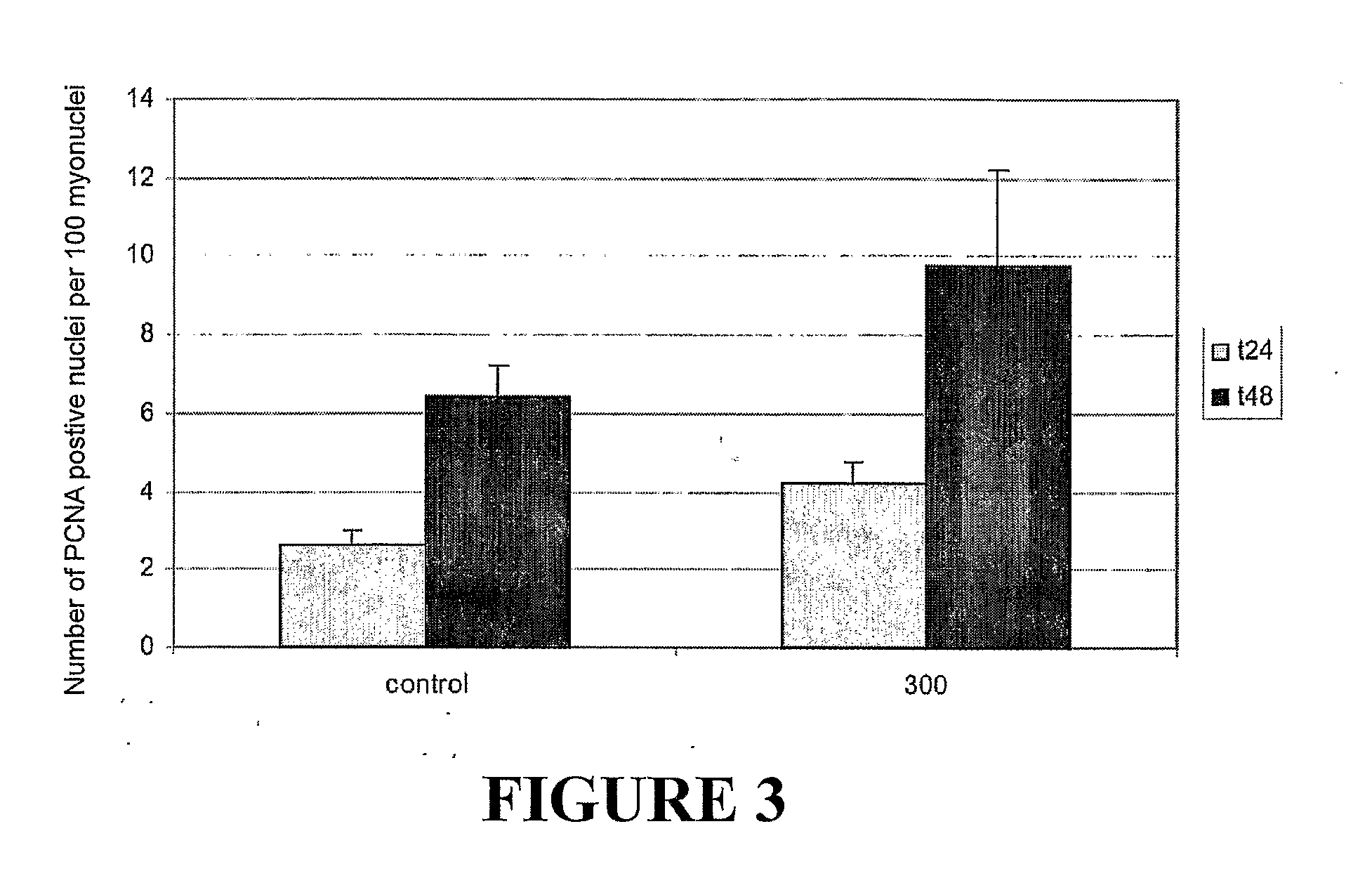Myostatin antagonists
- Summary
- Abstract
- Description
- Claims
- Application Information
AI Technical Summary
Benefits of technology
Problems solved by technology
Method used
Image
Examples
example 1
Myostatin Antagonists Increase Myoblast Proliferation In vitro
[0141]Methods
[0142]Expression and Purification of Myostatin Antagonists
[0143]A cDNA corresponding to the 267-329; 267-320; 267-310; 267-300; and 267-280 amino acids of bovine myostatin sequence, hereafter referred to as myostatin antagonist 329, 320, 310, 300, and 280 respectively, was individually PCR amplified and cloned into apET16-B vector using BamHI sites. Expression and purification of myostatin antagonists 329, 320, 25 310, 300, and 280 was done according to the manufacturer's (Qiagen) protocol under native conditions yielding peptides with an N terminal (M G H H H H H H H H H H S S G H I E G R H M L E D P) and C terminal tag (E D P A A N K A R K E A E L A A A T A E Q).
[0144]Myoblast Assay
[0145]Bovine C2C12 myoblasts were grown in Dulbecco's modified eagle medium according to the standard techniques (Thomas et al, 2000). The myoblast proliferation assay was carried out in uncoated 96-well microtitre plates. C2C12 ...
example 2
Myostatin Regulates Satellite Cell Activation
[0152]Methods
[0153]Single Myofibre Isolation and Culture
[0154]Single fibres were isolated as previously described Rosenblatt et al., (1995). Briefly, 1 and 24 month old wild-type mice were euthanized by CO2 gas followed by cervical dislocation. TA were dissected out and digested in 0.2% (w / v) type 1A collagenase (>260 CDU / mg, Sigma) in Dulbecco's modified Eagle medium (DMEM) (Invitrogen) for 60 minutes at 37° C. Muscles were transferred to DMEM +10% horse serum (HS) +0.5% chicken embryo extract (CEE) and fibres were separated by gentle trituration. Isolated fibres were transferred to 4 well chamber slides (Becton Dickinson) coated with 10% matrigel (Becton Dickinson) and fixed with 100% ice cold methanol for 10 minutes after culturing up to 72 hours at 37° C. in 5% CO2.
[0155]Proliferating Cell Nuclear Antigen (PCNA) is expressed in cells that are actively undergoing cell cycle but not in quiescent cells. A large percentage of the satellit...
example 3
Myostatin Antagonists Increase Inflammatory Response and Chemotaxis of Macrophages and Myoblasts
[0161]Methods
[0162]Chemotaxis Assay
[0163]Primary myoblasts were cultured from the hind limb muscle of young (4 to 6 week old) or old (24 month old) mice, according to the published protocols (Allen et al., 1997; Partridge, 1997). Briefly, muscles were minced, and digested in 0.2% collagenase type 1A for 90 min. Cultures were enriched for myoblasts by pre-plating on uncoated plates for 3 hours. Myoblast cultures were maintained in growth media (GM) supplemented with 20% fetal calf serum (FCS), 10% HS and 1% CEE on 10% Matrigel coated plates, at 37° C. / 5% CO2. The extent of culture purity was assessed by flow cytometry analysis of MyoD expression after 48 hours in culture. Cells were harvested using trypsin, suspended at a concentration of 106 cells / 200 μl and fixed overnight in 5 ml 70% ethanol at −20° C. Staining was performed for 30 min at room temperature using rabbit polyclonal anti-My...
PUM
| Property | Measurement | Unit |
|---|---|---|
| Mass | aaaaa | aaaaa |
| Therapeutic | aaaaa | aaaaa |
| Stability | aaaaa | aaaaa |
Abstract
Description
Claims
Application Information
 Login to View More
Login to View More - R&D
- Intellectual Property
- Life Sciences
- Materials
- Tech Scout
- Unparalleled Data Quality
- Higher Quality Content
- 60% Fewer Hallucinations
Browse by: Latest US Patents, China's latest patents, Technical Efficacy Thesaurus, Application Domain, Technology Topic, Popular Technical Reports.
© 2025 PatSnap. All rights reserved.Legal|Privacy policy|Modern Slavery Act Transparency Statement|Sitemap|About US| Contact US: help@patsnap.com



